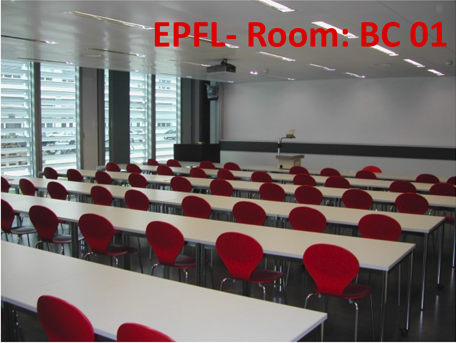Go to
Workshop Program in Detail
Workshop Schedule
Click here to download workshop schedule.
| Monday, 16 January 2012 | |
| 8:30 - 10:00 |
CAD Challenges in a Mobility Driven Era Noel Menezes |
| 10:00 - 10:30 |
Coffee & Discussion |
| 10:30 - 12:00 |
Device and Circuit Considerations for sub-22nm Technologies Kaushik Roy |
| 12:00 - 12:30 |
Discussion |
| 12:30 - 14:00 |
Lunch |
| 14:00 - 15:30 |
ASIP: The (too) long way from academia to product Heinrich Meyr |
| 15:30 - 16:30 |
Coffee & Discussion |
| Tuesday, 17 January 2012 | |
| 8:30 - 10:00 |
Capturing, Modelling and Leveraging Process Variability in IC Design Costas Spanos |
| 10:00 - 10:30 |
Coffee & Discussion |
| 10:30 - 12:00 |
Design technologies for next-generation heterogenous many-core platforms Luca Benini |
| 12:00 - 12:30 |
Discussion |
| 12:30 - 14:00 | Lunch |
| 14:00 - 15:30 |
Static timing for the other 99% Larry Jones |
| 15:30 - 16:30 |
Coffee & Discussion |
| Wednesday, 18 January 2012 | |
| 9:30 - 10:00 |
The Swiss Nano-Tera Program
Martin Rajman |
| 10:00 - 10:30 |
Coffee |
| 10:30 - 12:00 |
The Early Days of CMOS VLSI Design and CAD; Back to the Future Steve Kang |
| 12:00 - 12:30 |
Discussion |
| 12:30 - 14:00 |
Lunch |
| 14:00 - 15:30 |
Can Higher-Level Abstraction Help in Crossing the Brick Wall of Complexity? Rob Roy |
| 15:30 - 16:30 |
Coffee & Discussion |
| Thursday, 19 January 2012 | |
| 10:00 - 10:30 |
Coffee |
| 10:30 - 12:00 |
Energy Efficient Designs with Wide Dynamic Range Vivek De |
| 12:00 - 12:30 |
Discussion |
| 12:30 - 14:00 |
Lunch |
| 14:00 - 15:30 |
Protocol Verification in SOC Designs - An Industrial Experience John Moondanos |
| 15:30 - 16:30 |
Coffee & Discussion |
| Friday, 20 January 2012 | |
| 8:30 - 10:00 |
Scaling Trends of Energy Efficient, Low Voltage Operations David Blaauw |
| 10:00 - 10:30 | Coffee & Discussion |
| 10:30 - 12:00 |
Measuring and enhancing the reliability of CMOS circuits Sachin Sapatnekar |
| 12:00 - 12:30 |
Discussion |
| 12:30 - 14:00 | Lunch |
| 14:00 - 15:30 |
Are guardbanding and overdesign viable under 20nm? The case of voltage integrity George Stamoulis |
| 15:30 - 16:30 |
Coffee & Discussion |
Please see links given above for talk abstracts.
General Outline and Goals
Breakthroughs in integrated circuit processing technology have enabled the uninterrupted shrinking of silicon devices beyond 20nm. However, this came at the price of new design hurdles that need to be overtaken in the form of new design constraints that current design methodologies and CAD tools are ill-equipped to handle efficiently. Most importantly, CAD tools and methodologies, instead of being used to further enhance the performance gains and power savings inherent in every new process node, are hampering the exploitation of the process’ potential, leading to ever decreasing performance and power gains. The overdesign and guardbanding required by current design methodologies and imposed in part because of the disconnect between CAD tools and current design issues, and in part because of the increased anxiety and cost of a failed tapeout. This is leading into a dead-end situation in which methodology and tool imposed constraints on a design would swamp out the gains of moving into a new process. We need to “reinvent” the design process based on new CAD tools that meet the needs of today’s design teams.
It is widely accepted that there exists a stagnation in the electronic design automation (EDA) industry, which has hurt both the ability of extracting the maximum performance and power out of new process technologies, especially in the sub-45nm region, as well as the bottom line of EDA companies, which have seen their share of the total design budget shrink over the past five years. This is due to the fact that most design tools have had their basic functionalities crystallized in the 1980’s, with few breakthroughs making it to the mainstream since. However, the problems designers face have changed significantly since then. New design hurdles have arisen, with what were considered second order effects at the inception of current EDA tools becoming the major problems to be addressed. What were considered “reliability” issues have come to the forefront: voltage drop on the power supply network, thermal gradients and hot spots, transistor aging, inductive effects, electromigration, and signal integrity issues take up a major part of the design effort, significantly influencing the major design parameters of delay and power. The standard treatment of such issues through guardbanding and overdesign has run its course, and new solutions are required as designs drift ever further from the optimal with every process generation. Further complicating the aforementioned design issues are a) process variation, which is significantly larger in sub-45nm technologies and b) lithography effects that make circuit characterization significantly more complex as the minimum feature length becomes comparable to the light source wavelength. On the other hand, processing power and memory capacity are enabling solutions that were not possible even five years ago in simulation, modeling, and optimization technologies, which in tandem with new theoretical and algorithmic breakthroughs will enable at least 2X improvement in circuit performance, power, and reliability over those delivered by the current state-of-the-art methodologies and CAD tools.
Secondary navigation
- EPFL Workshop on Logic Synthesis and Emerging Technologies
- Luca Amaru
- Luca Benini
- Giovanni De Micheli
- Srini Devadas
- Antun Domic
- Rolf Drechsler
- Pierre-Emmanuel Gaillardon
- Jie-Hong Roland Jiang
- Akash Kumar
- Shahar Kvatinsky
- Yusuf Leblebici
- Shin-ichi Minato
- Alan Mishchenko
- Vijaykrishnan Narayanan
- Ian O'Connor
- Andre Inacio Reis
- Martin Roetteler
- Julien Ryckaert
- Mathias Soeken
- Christof Teuscher
- Zhiru Zhang
- Symposium on Emerging Trends in Computing
- Layout synthesis: A golden DA topic
- EPFL Workshop on Logic Synthesis & Verification
- Luca Amaru
- Luca Benini
- Robert Brayton
- Maciej Ciesielski
- Valentina Ciriani
- Jovanka Ciric-Vujkovic
- Jason Cong
- Jordi Cortadella
- Giovanni De Micheli
- Antun Domic
- Rolf Drechsler
- Henri Fraisse
- Paolo Ienne
- Viktor Kuncak
- Enrico Macii
- Igor Markov
- Steven M. Nowick
- Tsutomu Sasao
- Alena Simalatsar
- Leon Stok
- Dirk Stroobandt
- Tiziano Villa
- Symposium on Emerging Trends in Electronics
- Raul Camposano
- Anantha Chandrakasan
- Jo De Boeck
- Gerhard Fettweis
- Steve Furber
- Philippe Magarshack
- Takayasu Sakurai
- Alberto Sangiovanni-Vincentelli
- Ken Shepard
- VENUE
- Panel on Circuits in Emerging Nanotechnologies
- Panel on Emerging Methods of Computing
- Panel on The Role of Universities in the Emerging ICT World
- Panel on Design Challenges Ahead
- Panel on Alternative Use of Silicon
- Nano-Bio Technologies for Lab-on-Chip
- Functionality-Enhanced Devices Workshop
- More Moore: Designing Ultra-Complex System-on-Chips
- Design Technologies for a New Era
- Nanotechnology for Health
- Secure Systems Design
- Surface Treatments and Biochip Sensors
- Security/Privacy of IMDs
- Nanosystem Design and Variability
- Past Events Archive
Registration
Please note that paid registration is required for all participants of the workshop.
The full registration fee of 1200 € includes:
- Attendance to all lectures
- Printed and soft copy lecture notes
- Daily lunch with instructors
- All coffee breaks
- One social event (gala dinner)
Please click HERE to fill the online registration form.
Members of EPFL/ETHZ are offered a reduced rate for registration. EPFL/ETHZ members please click HERE to register.
For further information, you may contact Ms. Melinda Mischler by fax (+41 21 693 69 59) or e-mail (melinda.mischler@epfl.ch).


